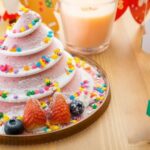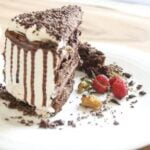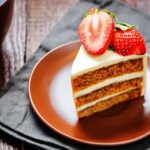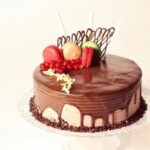Are you looking to add a professional touch to your homemade cakes? Learning how to decorate frosting on cake is the key to achieving visually stunning and delicious creations. Whether you’re a baking enthusiast or just getting started, mastering the art of frosting decoration can take your cakes to the next level.
Frosting is not only essential for adding flavor and moisture to your cakes, but it also serves as a canvas for creativity. From simple swirls and textures to intricate designs and patterns, the way you decorate your frosting can make a big impact on the overall presentation of your cake. In this article, we will explore the importance of frosting decoration and provide tips for achieving professional-looking results.
Understanding the different types of frosting, such as buttercream, fondant, and royal icing, is crucial for determining which one will work best for your desired decoration style. We will discuss how each type of frosting lends itself to different decorating techniques and aesthetics.
Additionally, we will cover the tools and equipment needed for successful frosting decoration, from basic piping bags and tips to advanced tools like mold presses and edible printing systems. Stay tuned as we delve into the world of cake decorating with frosting.
Types of Frosting
When it comes to decorating a cake, the type of frosting you use can make a big difference in the final look and taste of your creation. There are three main types of frosting commonly used for cake decoration: buttercream, fondant, and royal icing.
Buttercream is perhaps the most popular choice for frosting cakes due to its creamy texture and delicious flavor. This type of frosting is made with butter or shortening, powdered sugar, and flavorings such as vanilla or cocoa. It is versatile and easy to work with, making it a great option for both simple and intricate decorations.
On the other hand, fondant is a smooth, pliable icing that can be rolled out and draped over a cake for a clean, polished look. Fondant can also be used to create elaborate designs and 3D decorations that are sure to impress your guests. While some may find fondant too sweet or chewy, its ability to hold intricate designs makes it a favorite among professional bakers.
Lastly, royal icing is made from egg whites or meringue powder, powdered sugar, and water. It dries hard and smooth, making it ideal for intricate piping work, delicate lace designs, and even constructing gingerbread houses. Royal icing decorations are long-lasting and can add an elegant touch to any cake.
Each type of frosting has its own unique qualities and uses when it comes to decorating cakes. Whether you prefer the creamy texture of buttercream, the smooth finish of fondant, or the precision of royal icing, choosing the right frosting will ultimately depend on your personal preference as well as the design you want to achieve for your cake decoration project.
Choosing the Right Frosting for Decoration
When it comes to frosting decorations, one of the most crucial decisions to make is choosing the right type of frosting. The three most common types of frosting used for decorating cakes are buttercream, fondant, and royal icing. Each type has its own unique qualities and is suitable for different types of cake designs.
Buttercream is a versatile and popular choice for cake decoration due to its creamy texture and ability to hold various shapes when piped. It is also easy to flavor and tint, making it ideal for creating colorful and flavorful designs. Fondant, on the other hand, offers a smooth and polished finish that can be rolled out and draped over cakes for a flawless look.
It is perfect for creating intricate details such as ribbons, ruffles, and 3D figures. Royal icing is a hard-drying icing made from egg whites and confectioners’ sugar that creates a smooth, shiny finish. It is commonly used for delicate piping work and intricate lace-like designs.
When choosing the right frosting for decoration, consider the overall design of the cake, the desired level of texture or smoothness, as well as any flavor preferences. For example, if you are creating a cake with elaborate details or 3D figures, fondant may be the best choice due to its ability to hold its shape. However, if you prefer a softer texture with more flavor options, buttercream may be the preferred option.
It’s important to keep in mind that each type of frosting requires different techniques for application and decorating. Additionally advanced decorating techniques such as using edible flowers or decorative piping tips may only be suitable for certain types of frostings due to their textures or consistencies.
| Type of Frosting | Qualities |
|---|---|
| Buttercream | Versatile, creamy texture |
| Fondant | Smooth finish; ideal for detailed designs |
| Royal Icing | Hard-drying; perfect for intricate piping work |
Tools and Equipment Needed for Frosting Decoration
When it comes to decorating frosting on a cake, having the right tools and equipment can make all the difference in achieving a professional-looking result. Here are some essential items you will need for successful frosting decoration:
Piping Bags and Tips
Piping bags are a must-have for cake decorating, allowing you to easily apply frosting in various designs and patterns. Combine them with different piping tips to create unique shapes, flowers, borders, and more.
Offset Spatula
An offset spatula is a versatile tool for spreading frosting evenly on the surface of the cake as well as creating smooth finishes. Its angled design allows for precision and control while working with delicate decorations.
Turntable or Cake Stand
A turntable or cake stand is essential for achieving even and symmetrical frosting decoration. It allows you to rotate the cake while applying frosting, making the process smoother and more efficient.
Decorating Comb or Scraper
To achieve textured or patterned finishes on your frosting, consider using a decorating comb or scraper. These tools create decorative effects such as waves, stripes, or ridges that add visual interest to the cake’s appearance.
In addition to these items, other useful tools for frosting decoration include a bench scraper for smoothing sides of the cake, a palette knife for blending colors and textures, and food-safe brushes for painting on details with edible colorings. By having the right tools at your disposal, you’ll be well-equipped to create beautifully decorated cakes that are sure to impress.
Basic Frosting Decorating Techniques
Decorating a cake with frosting is a creative and fun way to add a personal touch to any baked creation. Basic frosting decorating techniques such as piping, spreading, and texturing can add depth, dimension, and visual interest to your cake. Whether you’re a beginner or an experienced baker, mastering these basic techniques is essential for creating beautiful and professional-looking cake decorations.
Piping
Piping is a classic frosting decorating technique that involves using a pastry bag and various tips to create intricate designs on the surface of the cake. To pipe frosting, fill a pastry bag with the desired frosting, hold it at a 90-degree angle to the surface of the cake, and apply even pressure to create lines, swirls, flowers, or other decorative elements.
Experimenting with different piping tips can yield different effects – for example, using a star tip can create beautiful rosettes or borders while a round tip can create precise lettering or dots.
Spreading
Spreading frosting on a cake may seem simple, but achieving an even and smooth finish requires practice and skill. To spread frosting evenly on the surface of the cake, start by applying a thin layer of frosting as a base coat. Use an offset spatula to spread the frosting in smooth, even strokes from the center outwards. For best results, take your time and work patiently to achieve a flawlessly smooth finish.
Texturing
Adding texture to your frosted cake can elevate its visual appeal by creating interesting patterns and designs. One popular texturing technique involves using an offset spatula or fork to create swirls or waves in the frosting. You can also experiment with combing tools specifically designed for adding texture to cakes.
These tools create unique patterns on the surface of the frosting that can give your cake a professional and artistic touch. Practice different texturing techniques on parchment paper or practice cakes before attempting them on your final creation.
Advanced Frosting Decorating Techniques
Decorating a cake with frosting can be taken to the next level by incorporating advanced techniques such as using fondant, edible flowers, and piping tips. These methods can elevate the appearance of your cake and turn it into a stunning centerpiece for any event or celebration.
- Using Fondant: Fondant is a versatile type of frosting that can be molded into various shapes and figures. It provides a smooth, polished finish to cakes and allows for intricate designs to be created. To use fondant in decorating, roll it out into a thin layer using a rolling pin and carefully drape it over the cake. Smooth out any air bubbles and trim the excess fondant for a seamless look.
- Incorporating Edible Flowers: Edible flowers can add a touch of elegance and natural beauty to frosting decorations. Flowers such as roses, violets, or pansies can be used to adorn cakes, providing not only visual appeal but also a delightful floral aroma.
- Utilizing Piping Tips: Piping tips come in various shapes and sizes, allowing for endless possibilities in creating decorative elements on cakes. From intricate lace patterns to intricate floral designs, piping tips offer precision and detail in frosting decoration.
By mastering these advanced frosting decorating techniques, you can transform an ordinary cake into a work of art. With practice and patience, you can achieve professional-looking results that will surely impress your family and friends on any occasion.
Tips for Achieving Professional-Looking Frosting Decorations
In order to achieve professional-looking frosting decorations on your cakes, it’s important to pay attention to detail and practice the proper techniques. One tip for achieving a polished look is to make sure that your frosting is at the right consistency.
Buttercream should be smooth and spreadable, while fondant should be pliable and easy to roll out. Additionally, using the right tools such as offset spatulas, piping bags, and decorating tips can make a big difference in the final result.
Another tip is to take your time and work systematically. Whether you’re piping intricate designs or smoothing out buttercream, rushing through the process can lead to uneven and sloppy decorations. By taking your time and working carefully, you’ll be able to create beautiful and professional-looking frosting decorations.
Finally, don’t be afraid to experiment with different techniques and designs. Practice makes perfect when it comes to frosting decoration, so try out new methods such as using edible flowers or creating texture with various piping tips. The more you practice and explore different styles, the more confident you’ll become in achieving professional-looking frosting decorations.
| Tip | Details |
|---|---|
| Frosting Consistency | Buttercream should be smooth and spreadable; fondant should be pliable. |
| Work Systematically | Take your time and work carefully for even and polished results. |
| Experiment with Techniques | Explore different styles like using edible flowers or piping tips for texture. |
Troubleshooting Common Frosting Decoration Mistakes
Decorating a cake with frosting can be a fun and rewarding experience, but it’s not without its challenges. There are common mistakes that can occur when decorating with frosting, but thankfully there are solutions to these issues. Here are some common frosting decoration mistakes and how to troubleshoot them:
1. Crumbs in the Frosting: One of the most frustrating issues when decorating a cake is getting crumbs in the frosting. This can make the surface appear messy and unprofessional. To avoid this, try using a crumb coat – a thin layer of frosting applied before the final layer – to seal in any loose crumbs.
2. Uneven Frosting: Achieving a smooth and even layer of frosting can be difficult, especially on larger cakes. If you’re having trouble getting your frosting to look uniform, try using a bench scraper or offset spatula to create an even surface.
3. Piping Mishaps: Piping intricate designs with frosting can be challenging, and it’s not uncommon for mistakes to occur. If your piping isn’t turning out as you’d like, practice on a separate surface first before applying it to the cake.
By troubleshooting these common frosting decoration mistakes, you’ll be able to achieve professional-looking results and create beautifully decorated cakes that will impress friends and family alike. Remember that practice makes perfect, and don’t be afraid to experiment with different techniques and tools until you find what works best for you.
Conclusion
In conclusion, decorating frosting on a cake is not only about making it visually appealing but also about showcasing creativity and skill. Whether you choose buttercream, fondant, or royal icing, the key to successful frosting decoration lies in choosing the right type of frosting for the desired effect and mastering basic and advanced decorating techniques.
With the right tools, equipment, and tips for troubleshooting common mistakes, anyone can achieve professional-looking frosting decorations that will impress guests and satisfy sweet cravings.
Remember that practice makes perfect when it comes to frosting decoration. Don’t be discouraged by initial failures; instead, use them as learning experiences to improve your skills. And don’t be afraid to get creative with your designs-experiment with different colors, shapes, and textures to make your frosting decorations truly unique.
In the end, decorating frosting on a cake is an art form that adds a special touch to any celebration. Whether it’s a birthday, wedding, or just a casual get-together, a beautifully decorated cake can elevate any occasion.
So take inspiration from various sources such as nature, art, or even fashion to create stunning designs that will leave a lasting impression on everyone who enjoys your delicious creations. With dedication and passion for frosting decoration success is only a piping bag away.
Frequently Asked Questions
How Do You Decorate a Cake With Frosting for Beginners?
Decorating a cake with frosting for beginners involves a few key steps. First, it’s important to make sure the cake is completely cooled before applying the frosting. Then, start by adding a thin layer of frosting as a base, known as the crumb coat, to seal in any loose crumbs.
Once that sets, you can apply a thicker layer of frosting and use a spatula or icing smoother to even it out. Finally, you can get creative with piping bags and different tips to add decorative designs or borders.
What Is the Proper Way to Handle Frosting When Decorating a Cake?
The proper way to handle frosting when decorating a cake is to make sure it’s at the right consistency for spreading or piping. If the frosting is too stiff, it will be difficult to spread smoothly, while if it’s too runny, it won’t hold its shape when piped.
It’s also important to work quickly once the frosting is on the cake, as it can start to set and become more difficult to manipulate.
What Is the Best Way to Apply Icing and Frost on a Cake?
The best way to apply icing and frost on a cake is to start with an offset spatula for spreading the frosting evenly across the top and sides of the cake. Then, use a bench scraper or straight-edge spatula to smooth out the surface for a clean finish.
If you’re using piping bags for decorative touches, choose the right tip for your design and make sure to maintain even pressure while piping. Practice makes perfect when it comes to getting comfortable with these techniques!

Welcome to my blog about home and family. This blog is a place where I will share my thoughts, ideas, and experiences related to these important topics. I am a stay-at-home mom with two young children. I hope you enjoy reading it! and may find some helpful tips and ideas that will make your home and family life even better!





